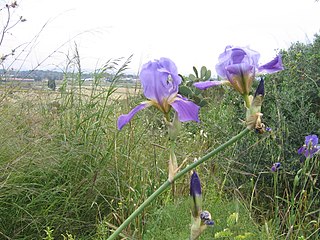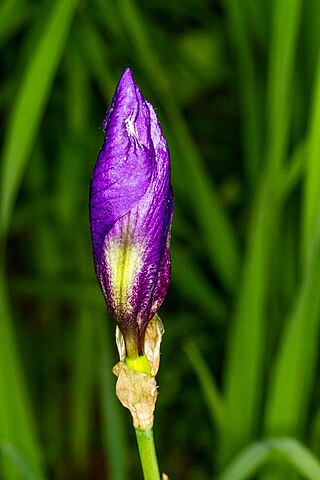
Iris variegata, commonly known as the Hungarian iris, is a plant species in the genus Iris, also in the subgenus Iris. It is a rhizomatous perennial from eastern Europe. It has dark green, ribbed leaves. The branched flowering stems can be as tall as the leaves, they can hold 2–3 flowers in summer. They are yellowish-white, with brown-purple veins on the drooping falls. It is very hardy and it is commonly cultivated as an ornamental plant in temperate regions. There are several cultivars.
Iris subdichotoma is a plant species in the genus Iris, it is also in the subgenus Limniris and in the section Lophiris. It is a rhizomatous perennial, from Tibet and China, with pale blue, blue-purple, purple, violet or white flowers. It is cultivated as an ornamental plant in temperate regions.
Iris cuniculiformis is a plant species in the genus Iris, it is also in the subgenus Iris and in the section Pseudoregelia. It is a rhizomatous perennial, from China, it has long and thin green leaves, and 1 lilac large flowers, that have yellow or grey beards. It is cultivated as an ornamental plant in temperate regions.
Iris goniocarpa is a plant species in the genus Iris, it is also in the subgenus of Iris and in the section Pseudoregelia. It is a rhizomatous perennial, from China, India, Burma and Bhutan. It has yellow green to dark green, long leaves, slender stem and, one flower between blue, lavender-blue, lilac, blue-violet or blue-purple. It is cultivated as an ornamental plant in temperate regions.
Iris benacensis is a plant species in the genus Iris, it is also in the subgenus Iris. It is a rhizomatous perennial, from Italy. It has similar sized leaves and stem, and blue-purple shaded flowers, that have a white, blue and yellow beard. It was once classified as a synonym of Iris aphylla, before being re-classified as a species in its own right, although some sources still call it a synonym. It is cultivated as an ornamental plant in temperate regions.
Iris cypriana is a plant species in the genus Iris, it is also in the subgenus Iris. It is a rhizomatous perennial, from Cyprus. It has narrow, glaucous and evergreen leaves, tall slender stem, with 2–3 branches, and 1–3 large flowers in lavender, lilac, red-lilac, to dark purple shades. It is cultivated as an ornamental plant in temperate regions. It is listed in some sources as a synonym of Iris germanica.

Iris furcata, the forked iris, is a plant species in the genus Iris, it is also in the subgenus Iris. It is a rhizomatous perennial, from the Caucasus mountains, in the countries of Moldavia and the southern Ukraine. It has short, narrow, sword-shaped leaves. A slender stem, that branches beyond the midpoint, holding small purple, deep purple, blue-violet, light blue or violet flowers. It is cultivated as an ornamental plant in temperate regions. It is often regarded as a synonym of Iris aphylla, but it has chromosomal and morphological differences, so it may considered to be a parent species instead.

Iris scariosa is a plant species in the genus Iris, it is also in the subgenus Iris. It is a rhizomatous perennial, from the mountainsides of Russia, Kazakhstan, Mongolia and China. It has sword-like, or sickle shaped, blue green or grey-green leaves, a short flowering stem, 3 or 4 membranous or semi-transparent flower bud leaves, 2 violet, reddish violet, lilac, blue-purple, or blue flowers in late spring, with yellow or white beards. It is cultivated as an ornamental plant in temperate regions. It was merged with another similar iris in the region, and Iris glaucescens became a synonym of Iris scariosa, before being divided into two separate species again. Although some sources still call it the main species, despite a slight colour difference.
Iris griffithii is a plant species in the genus Iris, it is also in the subgenus Iris. It is a rhizomatous perennial, from Afghanistan. It has short, sickle-shaped leaves, short green stem and purple flowers with white beards. Several specimens exist within herbaria around Europe, but it is rarely cultivated.

Iris junonia is a plant species in the genus Iris, it is also in the subgenus Iris. It is a rhizomatous perennial, from Cilicia, within the Taurus Mountains. It has glaucous short leaves, tall stems with several branches, numerous flowers in various colours from blue-purple, lavender, pale blue, cream, white and yellow, with brown veining and white tipped orange beards. It is cultivated as an ornamental plant in temperate regions. Its status is still unclear, if it is a synonym of Iris germanica or a separate species.

Iris kashmiriana is a plant species in the genus Iris, it is also in the subgenus Iris. It is a rhizomatous perennial, from Kashmir, India. It has straight, sword-shaped, glaucous leaves, tall, thick stem with up 2 short branches, which hold 2–3 flowers, which can be white, cream or pale blue, lilac, lavender or blue-purple. It is cultivated as an ornamental plant in temperate regions, although in Kashmir, it is also planted on graves.

Iris marsica is a plant species in the genus Iris, it is also in the subgenus Iris. It is a rhizomatous perennial, from the Apennine Mountains, in Italy. It has glaucous, sickle-shaped or curved, light green leaves, slender stem with 2 branches, and 3 violet, light blue violet, dark violet, and dark purple flowers. It was only found and described since 1973, and is not yet in general cultivation. It was once thought to be a form of Iris germanica, but has different morphological characteristics and different chromosomal differences.

Iris mesopotamica, the Mesopotamian iris, is a species in the genus Iris, it is also in the subgenus Iris. It is a rhizomatous perennial, from the middle East, within the countries of Iraq, Turkey, Syria and Israel. It has linear, grey-green or green broad leaves, tall stem with 2–3 branches, holding up to 9 scented flowers, in shades of violet, purple, lavender blue and light blue, with a yellow and white or orange and white beard. It is listed as a synonym of Iris germanica in some sources. It is cultivated as an ornamental plant in temperate regions, including being planted in graveyards and cemeteries but may also be used for celebrations and decoration.

Iris pallida subsp. cengialti is a subspecies in the genus Iris, it is also in the subgenus Iris. It is a rhizomatous perennial, from Italy and Slovenia. It has yellowish-green, glaucous, lanceolate or ensiform leaves, tall stem, green flushed with purple spathes, 2 short branches, 2–3 scented flowers, in shades of violet, blue-violet, deep purple, blue-purple, deep blue-purple, pale purple, deep blue, to mid-blue. It has a yellow or orange tipped beard. It was originally published as Iris cengialti but then re-classified as a subspecies of Iris pallida, and known as Iris pallida subsp. cengialti, but it is often still called Iris cengialti. It is cultivated as an ornamental garden plant in temperate regions.
Iris perrieri is a plant species in the genus Iris; it is also in the subgenus Iris. It is a rhizomatous perennial, from the Savoy Alps in southern France and recently in Italy. It has green, deeply ribbed, sickle shaped leaves, a slender stem with a branch, 1–3 scented flowers that are violet or purple, with a white or pale blue beard. It is rarely cultivated as an ornamental plant in temperate regions, due to its rarity in the wild. It was once thought to be a form of Iris aphylla, before cell (chromosome) analysis determined it to be a separate species.

Iris pallida subsp. illyrica, synonym Iris pseudopallida, is a subspecies of Iris pallida. It is a rhizomatous perennial from Croatia. It has flat, curved of sickle-shaped leaves, tall slender stems, 3–8 fragrant flowers, in shades of violet, or pale violet flowers, mauve, lavender, purple, yellow or white, between May and June. The iris was originally thought to be a separate species, but later classified as subspecies of Iris pallida, although in Croatia, it is still known as Iris pseudopallida. It is cultivated as an ornamental plant in temperate regions, especially in the Balkan regions.
Iris purpureobractea is a plant species in the genus Iris, it is also in the subgenus Iris. It is a rhizomatous perennial, from the cliffs and forest glades on the mountains of Turkey. It has straight or falcate shaped leaves, stem with several branches, the stem has purple spathes, it has up to 8 fragrant flowers, in various colours between yellow or blue. It is cultivated as an ornamental plant in temperate regions.

Iris sambucina, the elder scented iris, is a plant species in the genus Iris, it is also in the subgenus Iris. It is a rhizomatous perennial, from southern and central Europe. It has green, curved or sword-like leaves, tall round stem, multiple flowers in shades from brown violet, or brown-purple, to purple-violet, blue violet, mauve, and to purple. The large flowers are fragrant, with the scent of elderflowers, hence the name. It was first considered a separate species, then it was classified as a synonym of Iris germanica, before being classified as a separate species again, but with a hybrid origin from Iris pallida and Iris variegata. It is sometimes cultivated as an ornamental plant in temperate regions.
Iris schachtii is a plant species in the genus Iris, it is also in the subgenus Iris. It is a rhizomatous perennial, from central Anatolia, in Turkey. It has small, thin grey-green leaves, a short stem with 1–3 branches, which are normally, covered with a green leaf with purple staining. It has 2 or more fragrant flowers in late spring, which come in shades of yellow or purple, or violet and yellow,. It has a yellow or white with yellow-tips beard. It is cultivated as an ornamental plant in temperate regions, but prefers regions with dry, hot summers.

Iris subbiflora is a plant species in the genus Iris, it is also in the subgenus Iris. It is a rhizomatous perennial, from Portugal and Spain in Europe. It has evergreen broad leaves, forming dense clumps, it has dwarf stems in late spring,, with 1 upright fragrant flower, in shades of purple, light red purple, grey-blue, blue-violet, or dark violet. It has a beard which is generally blue, purple, or violet, but can fade to white, dull yellow, or dark yellow. After being found in 1804, it was once a separate species until the late 70s, when it was reclassified as subspecies of Iris lutescens, and renamed Iris lutescens subsp. subbiflora. But in the 80s it was returned to an independent species but some authors and references still class the species as a synonym or subspecies. It is cultivated as an ornamental plant in temperate regions.













